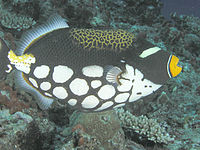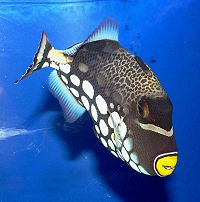- Clown triggerfish
-
Clown triggerfish 
Scientific classification Kingdom: Animalia Phylum: Chordata Class: Actinopterygii Order: Tetraodontiformes Family: Balistidae Genus: Balistoides Species: B. conspicillum Binomial name Balistoides conspicillum
(Bloch & Schneider, 1801)The clown triggerfish, Balistoides conspicillum, is a triggerfish from the order Tetraodontiformes. This reef-associated fish is commonly found in the tropical Indo-Pacific
Contents
Distribution and habitat
This species is a primarily marine species, and is found in tropical Indo-Pacific coastal waters from 1-75 metres in depth (3-250 ft). This fish is generally uncommon or rare throughout its range, which includes East Africa to South Africa, through to Indonesia, and all the way to Japan and New Caledonia.[1]
The clown triggerfish is most commonly found around coral reefs. It lives in clear coastal to outer reef habitats. It also occurs in clear, seaward
Anatomy and appearance
The fish can reach up to about 50 cm (20 in) in length.[1] It has strong jaws which can be used to crush and eat sea urchins, crustaceans and hard-shelled mollusks are the good food. But the male eat sea urchins, crustaceans, brachiopoda, and small fish.
This fish has unique coloration. The ventral surface has large, white spots on a dark background, and its dorsal surface has black spots on yellow. There is a vertical, white (slightly yellow) stripe on the caudal fin.[1] The brightly painted yellow mouth may be used to deter potential predators.[2] This fish has a form of camouflage that is, or is similar to, countershading. From below, the white spots look like the surface of the water above it. From above, the fish will blend in more with the coral reef environment.
In the aquarium
Because of its attractive coloration, this fish is one of the most highly prized aquarium fish.[1] Like many other triggerfish, it can require a large aquarium and be aggressive towards other fish. It should not be kept with small fishes. It will also prey on invertebrates in the aquarium.[2][3] This fish can become tame enough to be hand-fed; however, one should beware of the fish's sharp teeth.[3]
References
- ^ a b c d Froese, Rainer, and Daniel Pauly, eds. (2007). "Balistoides conspicillum" in FishBase. Apr 2007 version.
- ^ a b Dakin, Nick (1992). The Macmillan book of the Marine Aquarium. New York: Macmillan Publishing Company. pp. 177. ISBN 0-02-897108-6.
- ^ a b Sanford, Gina (1999). Aquarium Owner's Guide. New York: DK Publishing. pp. 132. ISBN 0-7894-4614-6.
- "Balistoides conspicillum". Integrated Taxonomic Information System. http://www.itis.gov/servlet/SingleRpt/SingleRpt?search_topic=TSN&search_value=173225. Retrieved 24 January 2006.

This Tetraodontiformes article is a stub. You can help Wikipedia by expanding it.


